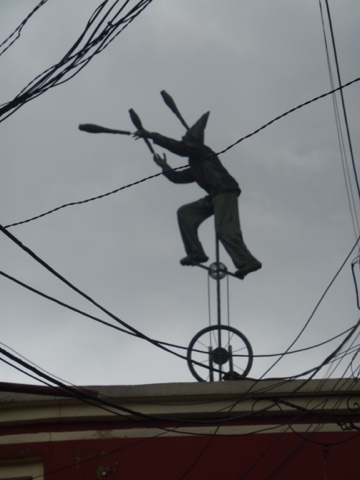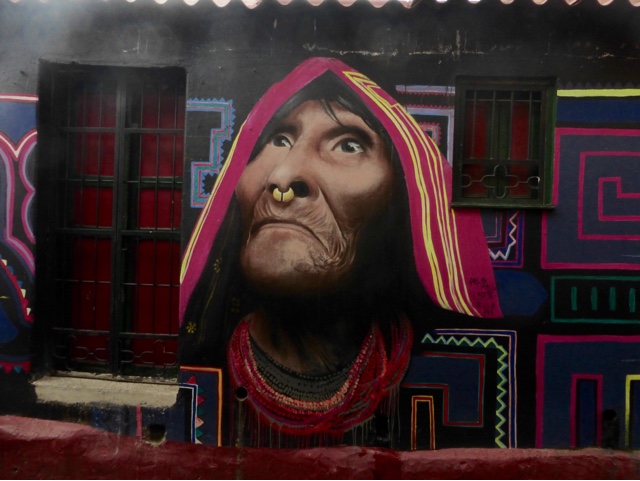Our charming chauffeur, Jose, at the top of the stairs, during a pit-stop to fix a puncture
First time in Bogota we stayed in the burbs and missed out on city life to a large extent, so this time we did the exact opposite and chose a hostel bang in the middle of backpacker land, in La Candelaria. What a great choice it turned out to be and, this time, we had great fun and liked Bogota much more.
Explora Hostel, our home for 3 nights in atmospheric La Candelaria
Gabriel, one of the Swiss travellers we'd met in Villa de Leyva, now leaving Explora Hostel for Cuba
However, he returned later that same day, having nearly been arrested at the airport for overstaying his visa allowance of 90 days. (He had been misinformed by a travel agent that Swiss citizens are automatically given 180 days and he didn't check the stamp.) Luckily, he was not detained for long and he had stayed only a few days over the 90. When we left him he was waiting to find out how much his fine would be ($400 a day had been mentioned by the immigration officials!)... And for his luggage to return from Havana!! Poor Gabriel. As we haven't heard from him, we hoping he's now happily in Cuba (where there is no internet access).
He's under there somewhere! (Before the fateful trip to the airport)
Beer cooler at Explora - no wonder it's so popular
In the street outside the hostel
La Candelaria has a large number of homeless people and is generally known to be 'edgy'. Street robberies are apparently common. We were just careful, as we would be in any city, and felt totally safe there.
A street in La Candelaria - this woman works in the laundry which did great job on our very grubby clothes
A stark reminder of the social problems of the city - invitation to parents to attend a workshop on domestic violence, addressed to 'little dads and mums'
Graffiti Tour
Street art is everywhere in Bogota. We'd heard good things about the Graffiti Tour, so booked places for our first full day in the city and did not regret it. So interesting, political and informative. Our excellent guide, Jeff, is an anthropologist and incredibly knowledgeable about street art. Sometimes, when explaining the fraught and oppressive relationship between the artists and the police, he took our group away from the street in case any police passing by overheard. He told us that in 2011, a 16 year old graffiti artist, Diego Felipe Becerra, was tagging a downtown wall when the police spotted him. The young man panicked and ran, the police opened fire and shot him, fatally, in the back. The police claims that he was taking part in an armed robbery did not stand up when the autopsy reported that he was shot in the back, at close range, was unarmed and had paint on this hands. The very next year, the lovely Justin Bieber visited Bogota and inadvertently sparked a graffiti revolution. He was given full police security when he sneaked out of his hotel to graffiti on a wall a cannabis leaf and a maple leaf, the little rebel. Not only did the police provide security, but they also closed the street while he doodled undisturbed. Initially, graffiti artists across the country vented their anger on social media against the police and Bieber. Then they realised that they had been handed a golden opportunity, to insist that if the police had protected the singer, then they must also protect every other graffiti artist, instead of harassing them, confiscating their sprays, imprisoning them, or even killing them. Graffiti artists mobilised in cities all over the country and, if they were challenged by the police, they reminded them that if Justin Bieber had been protected by law enforcement, so should they. Nowadays, graffiti is legal in most places, though the police still move artists on sometimes, or fine them. There is a graffiti festival every year on the anniversary of the young grafitero's death.
Many of the paintings are simply decorative, but others are political or social comments on life and politics in Colombia. Many grafiteros take their inspiration from the decades-long armed conflict between the government, paramilitary squads and left-wing guerrilla groups, that has left at least 50,000 dead and forced more than 4 million people to flee their homes.
Some of the more famous artists, originally from Australia and Barcelona, eg, have now settled in Bogota and make a living from their work, through commissions and world tours.
Work by Stinkfish
A 'tribal mask' by Australian, Crisp, a long-term Bogota grafitero (and physiotherapist!)
Dedicated to indigenous people who have suffered as a result of the war, by local grafitero, Katze 3
'Building the Impossible': work by Ecuadorian female artist, BLN Bike
May the force be with you, Polly (Crisp)
'We are memory': the attack on indigenous people and culture, including the use of herbicide to destroy coca crops
Guache's trademark geometric designs
Indigenous woman on a store selling chicha (alcoholic fermented corn drink), by Guache
By DjLu - the portrait on the right features Carlos, seen here, on the left!
DjLu often portrays local people in his work. We stood by this amazing wall, the work of several artists, which was, unfortunately, partly obscured by construction materials, while Jeff called Carlos' name. He emerged from a cafe and posed by his portrait.
'Tell us everything'
Work by Rodez (recognisable by his trademark: multiple eyes)
Don't know if we were just lucky or if this campervan is always parked there
Many business owners commission graffiti artists to paint the front wall of their shops. I'd much rather a beautiful graffiti design than ugly concrete or covered with random tags. We had a discussion about who we'd choose if we commissioned someone to graffiti our house in Brighton.... We think we'd go for a geometric design by Guache. Wonder if the neighbours would like it?
The graffiti images below are by DjLu, dubbed by some 'Bogota's Banksy'. Much of his work is political:
'The ugly are much more beautiful'
Guns 'n' Roses - shooting roses, not bullets
DjLu's take on the effect of Colombia's oil mining industry
The Spanish word 'esposas' means both wives and handcuffs!
A shop selling coca tea etc in a narrow cobbled street in La Candelaria
The tour was fantastic and a great way to see and learn about the city's history and politics. It was free, but guides are paid by donation only and the suggested amount is $5-$6 pp - well worth it for the 2 1/2 hour experience. Tours are twice daily, every day. If you're in Bogota don't miss it: http://bogotagraffiti.com/#_=
A street on the outskirts of La Candelaria
Not strictly street art, but we liked this area of torn-off posters
This is an amalgam of gold and copper, thus the gorgeous verdigris
Little clay figure
Gold funerary mask
This centuries old funerary mask reminded us of grafitero Crisp's 'tribal masks'
Spindle weights
Spooky
Back in the street, a puppeteer
On our last day in Bogota, we had breakfast in a little cafe owned by a Swiss/German couple. The bread looked amazing, and it had been recommended to us by our Swiss friend, Sebastian. The breakfast was indeed delicious, pain au chocolat, bread baked on the premises, home-made jam... Yum. The German woman co-owner chatted angrily about Colombian politics and the lot of many ordinary people, who feel powerless and do not speak out against or even complain in private about the exorbitant costs of essential goods and amenities. She was furious about the resignation of the people, who seem to accept that nothing can be done about the situation. She went on to explain about the lack of health and social provision, telling us of a German woman who has set up, single-handedly, a foundation for young people with learning disabilities in Bogota. We ended up going to visit Teresa, an inspirational woman with boundless energy, in her tumbledown apartment in La Candelaria, where she runs workshops with 8 people with learning disability, who would otherwise be at home, invisible and without support from local or national government. Teresa has acquired the use of an area of disused land opposite her building and, with her clients, has turned it into a productive market garden, using permaculture principles. They sell their produce to a local organic cafe. Some of her clients have also started work experience in local cafes and in other jobs. One of her clients cannot speak or hear and we discussed ways of acquiring low-tech communication aids, with which I hope to help out. We were humbled by this indefatigable woman, who, with a little financial support from German organisations and none from Colombian sources, is determined to succeed in her mission to provide services for people who otherwise have none.
If you are interested in finding out more about the work of Proyecto Friese, go to:
Donations are always needed:
So, it was completely worth giving Bogota another try and we're so glad we did. Our three days there were very varied and well-spent.
Next post: Colombia's South: San Agustin and Popayan

































































